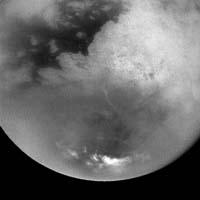The thunder of Titan is made of methane

Two years ago scientists began to explore in detail Titan, the largest satellite of Saturn. In fact, the images taken by the Cassini spacecraft and the measures taken by the Huygens probe have revealed that on the surface of this cold world there are recently formed dry canals and riverbeds. If so, it would be the first example of regular accumulation of fluids throughout the solar system beyond the Earth. How can these structures form in such a cold place? Are they caused by rain? And if so, what kind of rains?
The doctors of the UPV, Ricardo West and Agustín Sánchez Lavega, propose in the study published in the journal Nature that in Titan there are gigantic clouds of thunder formed by methane vapor. According to the calculations, these powerful clouds of thunder can reach 35 kilometers of surface and from bottom to top, and they emit numerous droplets of methane, as well as the heavy torrential rains that are produced by terrestrial thunder. These precipitations would allow to create and flow in Titan liquid methane wells and rivers capable of forming the observed channels.
The researchers have made this hypothesis because they have seen from the orbit of Cassini and from the great telescopes of the Earth bright clouds repeatedly taken in very specific places. One of the places where more broad fog masses are formed is the south pole. In the polar region it is warmer in summer than anywhere else in the satellite, that is, it slightly increases the temperature and generates energy to form thunder, according to researchers. Thus, they discover that one of the key elements for the formation of titanium thunder is the small particles called condensation nuclei. These particles allow the growth of methane ttanttas and the formation of thunder mists. This methane would be present in the atmosphere in small quantities.





